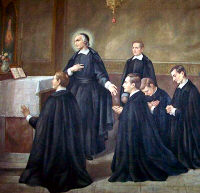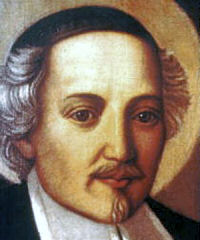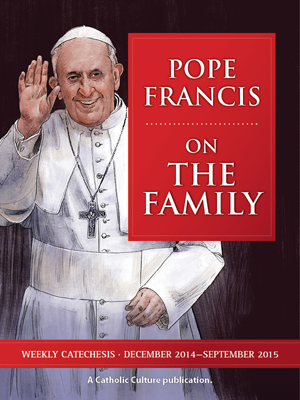Ordinary Time: August 19th
Saturday of the Nineteenth Week in Ordinary Time; Optional Memorial of St. John Eudes, Priest
Other Commemorations: St. Louis of Toulouse, Bishop (RM)
» Enjoy our Liturgical Seasons series of e-books!
Today is the Optional Memorial of St. John Eudes (1601-1680) was born in Ri and died in Caen, France. Despite the prevailing rigors of Jansenism, he received First Communion when only a child. He studied in Paris and was ordained a priest in 1625. He soon became an outstanding missionary among his plague-stricken countrymen, living an irreproachable life and devoting all his energies to the cause of Christ. In 1643 he founded the Society of Jesus and Mary (Eudists) to preach missions to the people, direct seminaries, and conduct retreats for the clergy. He was a great opponent of the Jansenistic heresy, and always showed an unchanging devotion to the Holy See.
The Roman Martyrology also commemorates St. Louis of Toulouse (1274-1297), the son of Charles II of Anjou, king of Naples, was the great-nephew of Saint Louis IX, and of Saint Elizabeth of Hungary. He grew up in Provence (in modern France) and spent seven years as a hostage for his father at Barcelona and Tarragona in Spain. He was ordained at age 23.
St. John Eudes
 Born on a farm in northern France, St. John was a religious, a parish missionary, founder of two religious communities and a great promoter of the devotion to the Sacred Heart and the Immaculate Heart of Mary. He joined the religious community of the Oratorians and was ordained a priest at twenty-four. During severe plagues in 1627 and 1631, he volunteered to care for the stricken in his own diocese. Lest he infect his fellow religious, he lived in a huge cask in the middle of a field during the plague.
Born on a farm in northern France, St. John was a religious, a parish missionary, founder of two religious communities and a great promoter of the devotion to the Sacred Heart and the Immaculate Heart of Mary. He joined the religious community of the Oratorians and was ordained a priest at twenty-four. During severe plagues in 1627 and 1631, he volunteered to care for the stricken in his own diocese. Lest he infect his fellow religious, he lived in a huge cask in the middle of a field during the plague.
At age thirty-two, John became a parish missionary. His gifts as preacher and confessor won him great popularity. He preached over one hundred parish missions, some lasting from several weeks to several months.
In his concern with the spiritual improvement of the clergy, he realized that the greatest need was for seminaries. He had permission from his general superior, the bishop and even Cardinal Richelieu to begin this work, but the succeeding general superior disapproved. After prayer and counsel, John decided it was best to leave the religious community. The same year he founded a new one, ultimately called the Eudists (Congregation of Jesus and Mary), devoted to the formation of the clergy by conducting diocesan seminaries. The new venture, while approved by individual bishops, met with immediate opposition, especially from Jansenists and some of his former associates. John founded several seminaries in Normandy, but was unable to get approval from Rome (partly, it was said, because he did not use the most tactful approach).
 In his parish mission work, John was disturbed by the sad condition of prostitutes who sought to escape their miserable life. Temporary shelters were found but arrangements were not satisfactory. A certain Madeleine Lamy, who had cared for several of the women, one day said to him, "Where are you off to now? To some church, I suppose, where you'll gaze at the images and think yourself pious. And all the time what is really wanted of you is a decent house for these poor creatures." The words, and the laughter of those present, struck deeply within him. The result was another new religious community, called the Sisters of Charity of the Refuge.
In his parish mission work, John was disturbed by the sad condition of prostitutes who sought to escape their miserable life. Temporary shelters were found but arrangements were not satisfactory. A certain Madeleine Lamy, who had cared for several of the women, one day said to him, "Where are you off to now? To some church, I suppose, where you'll gaze at the images and think yourself pious. And all the time what is really wanted of you is a decent house for these poor creatures." The words, and the laughter of those present, struck deeply within him. The result was another new religious community, called the Sisters of Charity of the Refuge.
He is probably best known for the central theme of his writings: Jesus as the source of holiness, Mary as the model of the Christian life. His devotion to the Sacred Heart and to the Immaculate Heart of Mary led Pius XI to declare him the father of the liturgical cult of the Hearts of Jesus and Mary. He was also the author of several books which served his work, e.g., The Ideal Confessor and The Apostolic Preacher. He died at the age of seventy-nine.
—Excerpted from the Saint of the Day, Leonard Foley, O.F.M.
Symbols and Representation: Priest with or presenting the Sacred Hearts of Jesus and Mary
Patronage: diocese of Baie-Comeau, Québec
Highlights and Things to Do:
- Learn more about St. John Eudes:
- St. John founded the Congregation of Jesus and Mary also known as the Eudists. See the rest of the Eudist religious family.
- See St. John Eudes' Founder's Statue in St. Peter's Basilica.
- Several translated St. John Eudes' books can be found at Bibliothèque Saint Libère.
St. Louis of Toulouse
 St. Louis's father was King Charles II of Naples and Sicily. Charles, then a prince, was imprisoned by the King of Aragon; as a condition of Charles' release in 1288, Louis and two brothers were sent to Barcelona as hostages. There Louis was cheerful and took part in sports with other prisoners. He was also influenced by the Franciscans, and he prayed with them at night. Louis was given his freedom after seven years when a treaty was concluded with King James II of Aragon. It was proposed that Louis marry King James' sister, but he refused both marriage and the crown of Naples. He received a papal dispensation to be ordained a priest and consecrated a bishop at the age of 23. Louis went to Rome in 1296, and five days after being professed among the Franciscans, he was consecrated Bishop of Toulouse. At Toulouse, Louis was modest, wearing an old Franciscan habit, and his devotion was an inspiration to his flock. Within a few months, however, he asked for permission to resign his office, which he had accepted out of obedience, since he felt that its duties were more than he could handle. He died in 1297, not yet 24 years of age.
St. Louis's father was King Charles II of Naples and Sicily. Charles, then a prince, was imprisoned by the King of Aragon; as a condition of Charles' release in 1288, Louis and two brothers were sent to Barcelona as hostages. There Louis was cheerful and took part in sports with other prisoners. He was also influenced by the Franciscans, and he prayed with them at night. Louis was given his freedom after seven years when a treaty was concluded with King James II of Aragon. It was proposed that Louis marry King James' sister, but he refused both marriage and the crown of Naples. He received a papal dispensation to be ordained a priest and consecrated a bishop at the age of 23. Louis went to Rome in 1296, and five days after being professed among the Franciscans, he was consecrated Bishop of Toulouse. At Toulouse, Louis was modest, wearing an old Franciscan habit, and his devotion was an inspiration to his flock. Within a few months, however, he asked for permission to resign his office, which he had accepted out of obedience, since he felt that its duties were more than he could handle. He died in 1297, not yet 24 years of age.
—Excepted from the Saints Calendar & Daily Planner, TAN Books
Symbols and Representation: boy bishop; young bishop with a crown by his feet; young man in pontifical garments and holding a book and a crosier
Patronage: Valencia, Spain; Mission San Luis Obispo de Tolosa, California
Highlights and Things To Do:








